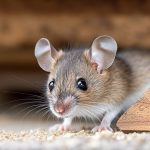How Do Mice Get in Attic? Cracking the Code of Their Covert Entry Strategies
When it comes to maintaining a peaceful and rodent-free home, the last place you want to find unwanted guests is in your attic. However, these pesky creatures have an uncanny ability to infiltrate even the most fortified spaces.
So, how do mice get in attic? Well, mice possess an uncanny ability to squeeze through impossibly small openings, scale walls, and wires. They will climb and exploit construction gaps and openings. They can even gnaw through materials to forge new paths.
This article will shed light on the methods these tiny invaders employ to gain access. So, read on to learn how to minimize their intrusion.
How Do Mice Get in Attic?
Below are methods that mice use to find their way into your attics:

1. Climbing and Scaling
Mice are agile climbers. Their climbing abilities enable them to access attics by finding alternative routes and bypassing traditional barriers. Here’s a closer look at how mice climb and scale to gain entry:
- Exterior walls: Mice can easily climb exterior walls by gripping various surfaces. By exerting force against the wall and making small jumps or hops, mice can ascend to higher levels.
- Utility lines and cables: These rodents are adept at traversing utility lines that connect to your home, using their claws to grip the wires while maintaining their balance.
- Vegetation and vines: These include nearby trees, shrubs, or climbing vines. They climb tree trunks, using their claws and nimble bodies to navigate branches until they reach the roofline.
- Outdoor structures: Examples include trellises, fences, or latticework. These structures offer additional surfaces for mice to grip onto as they ascend.
- Drainpipes and downspouts: Mice can climb up these structures with the aid of the textured surface of the pipes. They will navigate their way to the roofline and eventually to your attic.
2. Gnawing Through Weak Points
Mice have continuously growing incisor teeth that drive them to gnaw on various materials. When faced with an obstacle, they may use chewing and gnawing to create new entry points.

3. Construction Gaps
During construction, gaps and openings may be inadvertently left behind, providing potential entry points for mice to infiltrate attics. Here are the gaps that mice utilize:
- Utility penetrations: Construction gaps can occur around utility penetrations, such as pipes, cables, or vents, that pass through walls, floors, or ceilings.
- Unsealed points: During construction, areas where different building materials meet, such as corners, joints, or seams, may contain small gaps or openings. These unsealed entry points allow mice to enter wall cavities, crawl spaces, and attics.
- Structural settling: Structures can settle and shift slightly over time, resulting in small gaps or separations between building components. This settling can create new access points for mice to exploit.
4. Roof Openings
Roof openings can give mice direct access to attics, allowing them to establish nests and seek shelter within your home. Here are various types of roof openings that mice may exploit:
- Damaged or missing shingles: Mice can take advantage of damaged or missing shingles on your roof. Whether caused by weathering, age, or external factors, compromised shingles create gaps or openings that mice can exploit.
- Loose or damaged roof vents: Roof vents, such as ridge vents or gable vents, can become entry points for mice if they are damaged.
- Skylights and roof windows: These become entry points for mice if they are damaged, improperly sealed, or have gaps around their frames.
Why do Mice Enter Attics?

Mice enter through this structure for three main reasons. They include the following:
- Shelter: Attics provide mice with a secluded and protected shelter, shielding them from outdoor elements and potential predators.
- Food sources: Attics can offer a variety of food sources that entice mice. This includes stored items such as cardboard boxes, fabric, or paper. Also, attics may harbor insects, spiders, or other small creatures as a food source for mice.
- Nesting materials: Attics often contain abundant suitable nesting materials for mice. Insulation, fabric, shredded paper, or other soft materials can be found in attics, providing mice with comfortable nesting materials.
How Can I Tell My Attic Is Infested by Mice?

Here are some common indicators that can help you determine if mice infest your attic:
- Droppings: Mouse droppings are small, typically around 3-8mm long, and resemble dark pellets. Look for these droppings in your attic, especially near nesting areas, food sources, or pathways where mice may be active.
- Gnaw marks: Look for gnaw marks on your attic’s wooden beams, insulation, wires, or other objects.
- Urine stains and odor: Mice use urine to mark their territory and communicate with other mice. If your attic has a strong, musky odor that persists despite proper ventilation, it could indicate a mouse infestation.
- Nests: These creatures also build nests using available materials like insulation, fabric, paper, or shredded materials. Check for signs of nesting in your attic, such as small, cozy nests hidden in secluded areas or tucked away in corners.
- Grease marks: As mice navigate your attic, their fur can leave greasy marks. You will see these along walls, beams, or other surfaces they frequently encounter.
- Scratching or scurrying noises: Mice are nocturnal. This means they are mainly active at night. So listen for scratching or scurrying sounds from the attic during the evening or early morning hours.
- Visual sightings: In some cases, you may directly observe mice in your attic or spot them scurrying across beams or along walls. However, they quickly retreat into hiding if they sense human presence.
How to Get Exterminate Mice in the Attic?
Removing mice in the attic requires a systematic approach to eliminate the infestation and prevent future occurrences. Here are steps you can take to address the problem effectively:

Step 1. Identify Entry Points
Inspect your attic thoroughly to identify potential entry points that mice use to access the space. Seal these entry points using materials like steel wool, caulk, or expanding foam to prevent mice from entering.
Step 2. Remove Attractants
Eliminate potential food and water sources that attract mice to your attic. Store food in sealed containers, clean up food spills promptly, and secure garbage bins tightly.
Also, fix any leaks or sources of standing water to remove water sources that may attract mice.
Step 3. Declutter and Organize
Remove any clutter or unnecessary items in your attic that could provide mice hiding places or nesting materials. Keep the attic well-organized to minimize potential hiding spots.
Step 4. Traps
Place the traps along known mouse pathways, near entry points, or where droppings or signs of activity are present. Bait the traps with foods like peanut butter, chocolate, or dried fruits to attract mice.
Step 5. Repellents
Consider using natural deterrents such as peppermint oil, mothballs, or ammonia-soaked rags in areas where mice are active. These strong scents may discourage mice from staying in the attic. You can also buy ultrasonic devices.
Step 6. Regular Monitoring and Maintenance
Even after successfully eliminating mice from the attic, monitoring the space regularly for any signs of new activity is crucial. Continue to seal off potential entry points and maintain good hygiene practices to prevent future infestations.
Getting rid of mice can be a challenge, especially when they find their way to elevated spots in our homes. While it’s common for mice to invade attics, understanding their behavioral patterns can help in devising strategies to deter them. One intriguing method involves using a ubiquitous kitchen ingredient. Explore how vinegar can potentially deter these rodents by visiting how to get rid of mice with vinegar. Additionally, for homeowners curious about less obvious signs of a mouse infestation aside from the typical droppings, delve into signs of mice but no droppings.FAQs
Here are answers to common questions that will come up in the process:
Q: Are There Any Health Risks Associated with Mice in the Attic?
Yes, mice in the attic pose health risks. They contaminate surfaces and food with droppings, urine, and saliva, potentially spreading diseases. Mice can also introduce parasites like fleas, ticks, or mites into your home.
Q: When Should I Seek Professional Help for a Mouse Infestation in the Attic?
We recommend doing so if the problem persists despite your efforts. If you’re dealing with a large-scale infestation, you also need help. A professional will also help if you’re uncertain about proper handling and elimination techniques.
Q: How Long Does it Take to Get Rid of Mice in the Attic?
It can take a few days to several weeks to eliminate mice from the attic. The time required to get rid of mice in the attic depends on several factors. This includes the size of the infestation, the effectiveness of control methods used, and the measures taken to prevent reinfestation.
Conclusion
Knowing the answer to how do mice get in attic is key to effectively preventing and addressing infestations. These rodents use methods like squeezing through small gaps, climbing and scaling surfaces, exploiting roof openings, and gnawing through weak points.
By recognizing their methods, you can take proactive measures to fortify your attic against these crafty invaders. Set up traps, use deterrents, and consider seeking professional help when needed. Remember, prevention is key.




